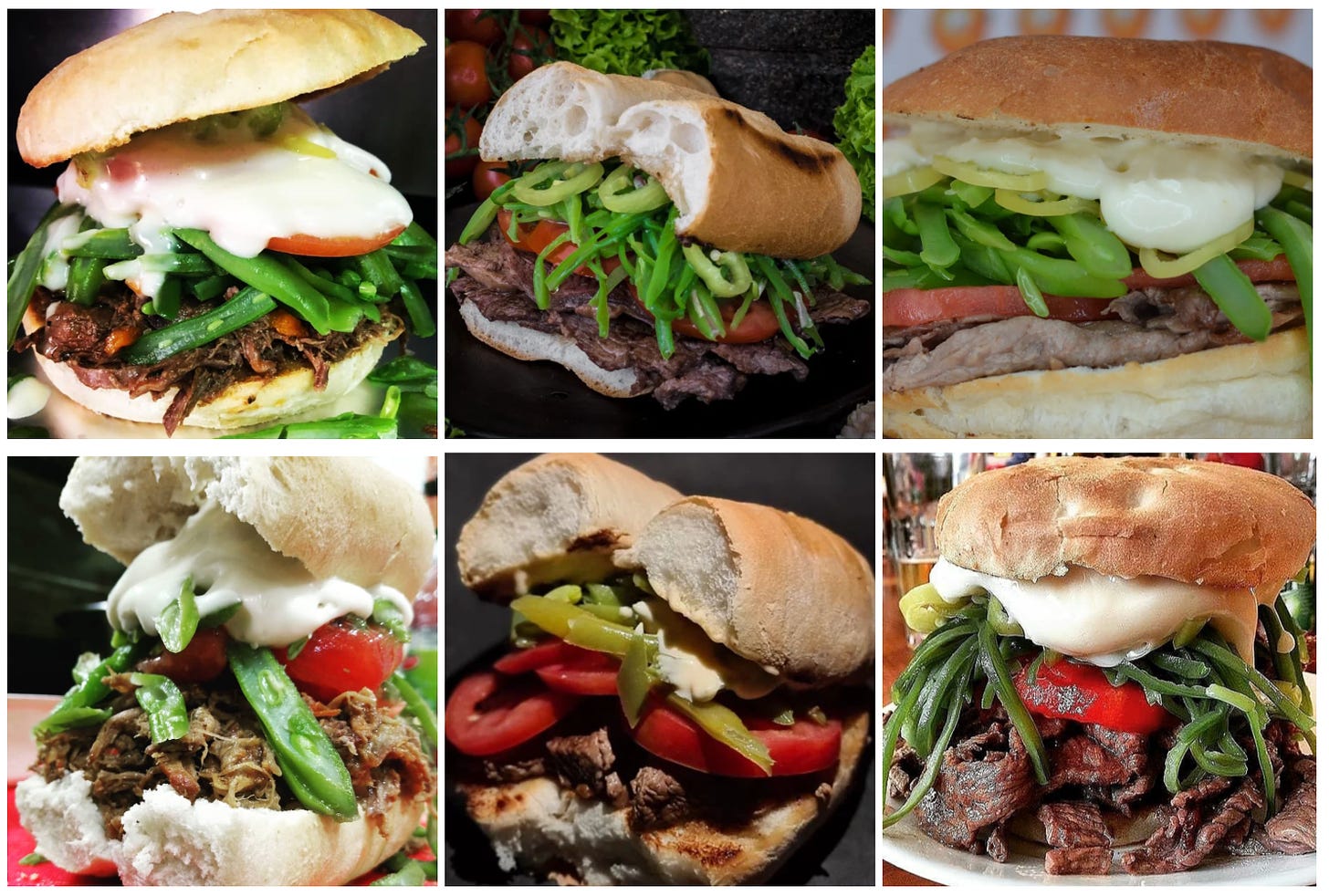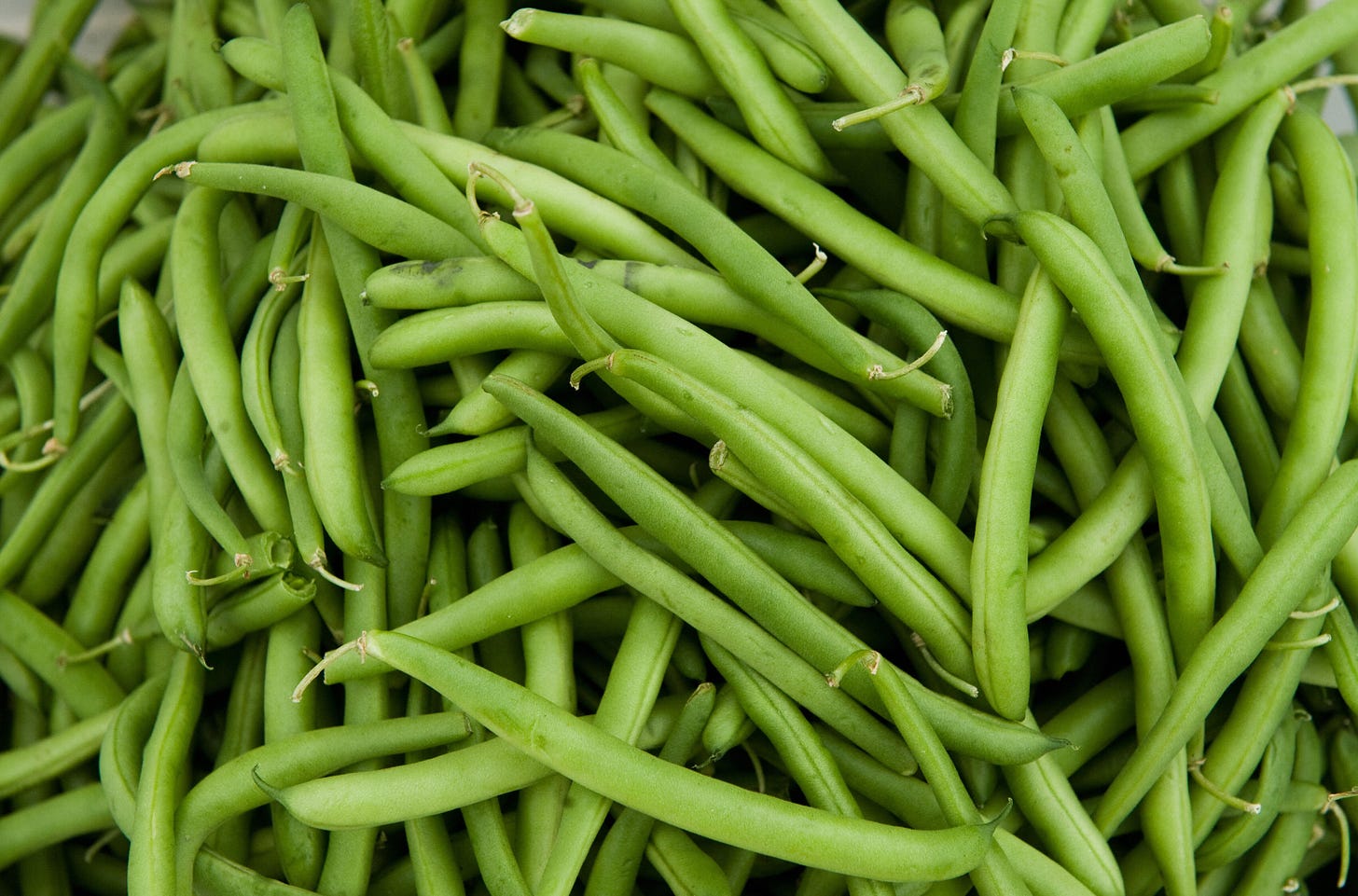Notable Sandwiches #29: The Chacarero
Grilled steak and a hill of beans make for a Chilean summer staple
Welcome back to Notable Sandwiches, the feature in which I, alongside my editor David Swanson, trip merrily through the profoundly odd and ever-changing document that is Wikipedia’s List of Notable Sandwiches. This week: a Chilean staple, el chacarero.
It’s been a while since we had one of our regular sandwich features—largely a function of my own severe malaise (it’s hard to make yourself write about sandwiches when the world is burning), a holiday break, and other personal inconveniences. To tell the truth, the chacarero did not draw me in as a natural subject of some poetic effulgence—while it appears to be beloved of Chileans, the sandwich itself appears odd through the lens of the narrow North American palate. It’s a beef sandwich, one of the countless iterations on cowflesh—churrasco—that adorn the cuisine of South America thanks to the prominence of the cattle industry there. What distinguishes the chacarero in particular is its additions: to a thin-sliced top-sirloin steak, add tomatoes, aji peppers, sometimes cheese, and—unaccountably, but indispensably—green beans. This agricultural excess explains its etymology: chacarero also means a small-scale farmer, who works on a chacra, a small farm or ranch, making his living off the land. The sandwich is served on a hallulla roll, a flattish, milk-brushed construction ideal for thin slicing, sturdy enough to contain the unlikely concatenation of the garden and the corral the chacarero demands.
According to Pilar Hernandez, author of The Chilean Kitchen, the chacarero is a “traditional summer sandwich”—one that’s available all year round, but “suffers when the tomato is not a summer tomato.” The green beans are not optional, and they must be cut in the French manner and, she tells me, “expertly blanched, so they are very green and succulent.” I am not a particularly avid consumer of beef—not out of any particular salutary environmental principle, just a matter of personal taste and an aversion to the stringy chewiness of beef even slightly ill prepared. I am an avid eater of tomatoes, which I consume apple-like with a pinch of salt. And of green beans I am not merely a lover, but a grower, cultivator of these eager plants with their plate-sized leaves, their curling fruits. I have never thought of my tiny verdant companions as sandwich accouterments—they’re better solo, fresh and snapping, lightly sautéed with garlic, or arranged gridwise under a roasting chicken to absorb every precious drip of schmaltz. An Eater rundown of New-York-area chacarero sandwiches found dispiriting results, with the beans ranging from “squishy” to “unnatural.”
The Sword and the Sandwich is a newsletter about deadly serious extremism and equally serious sandwiches. Please consider supporting this work with a paid subscription:
According to the Chilean writer Isidora Diaz, the chacarero is a vivid exception to the Chilean-sandwich norm, which admits little vegetal matter, preferring dense, fatty creations. “We like melted cheese, mashed avocado, and mayonnaise that grossly overflows and leaks out of the bread, the dish, and the world, because we love mayonnaise and avocado and cheese sandwiches and without them life would be meaningless,” she writes. “However, there is sufficient reason for such abundance: all other ingredients in our sandwiches are quite meager… There is only one (and wonderful) exception: El Chacarero, the seasonal sandwich with slices of sautéed beef, tomatoes, green beans and ají cristal, all summer ingredients from the farm (or garden), hence the name.”
I’ve written here before about my garden—my first garden, and the thrill, at thirty-two, of discovering a new great love in myself, and a new capacity for loving, which is rare enough in any life. In my small concrete enclosure, in twenty-four planters of wildly varying sizes, I am nurturing my crops through the relentless heat of summer, hauling water up and down the stairs like a handmaid filling a hip-bath. The borage is starting to bloom purple, and as I amble through the rows the scents of marjoram, thyme, oregano, mint, rosemary, basil, and leggy, nodding dill gloriously confuse the nostrils. Morning-glory sprouts grow along the fence, tomato plants suck every drop from the soil. I’ve grown nearly all of this from seed—a few plants from the supermarket’s flower stall have grown shaggy and wild under steady watering and a foul-smelling fish-skeleton fertilizer concoction. The carrots are growing their impossibly tender tiny leaves, the sunflowers are climbing over the pumpkins, two planters full of wildflowers are starting to bloom.
My garden isn’t a chacra—just a concrete square infused with my care and ambition—but the first crops I harvested were the green beans. I’d never quite understood the myth of Jack and the Beanstalk until I planted green beans: from the moment of sprouting they hurtled toward the sky. They threw out fat green leaves, shot up with feverish haste, put out flowers, then fruit, all in little over a month: every time I looked they had grown further, grasped a new piece of their trellises with their minute tendrils. I could imagine a minute climber hoisting himself from fragile limb to fragile limb all the way up to heaven. The new beans were sticky with fuzz, swollen with their inner fruit, and broke off readily into my hands, the first true comestibles I’d drawn from the earth.
According to Hernandez, Chileans do not serve the green bean as a side, but insert them into the heart of a broad variety of dishes. “You go to the backyard garden and get the day’s harvest, twenty green beans, say,” she told me. “You chop them and add them to the cazuela de pollo, the charquican.” Summer’s on and the bean leaves hang down in the heat and fade, but still they put out their curling fruit, new seed for new plants, to grow with equal speed in the coming season. I take most, but I leave some, and I bathe the black earth, and wait for the fruit and the flower.







